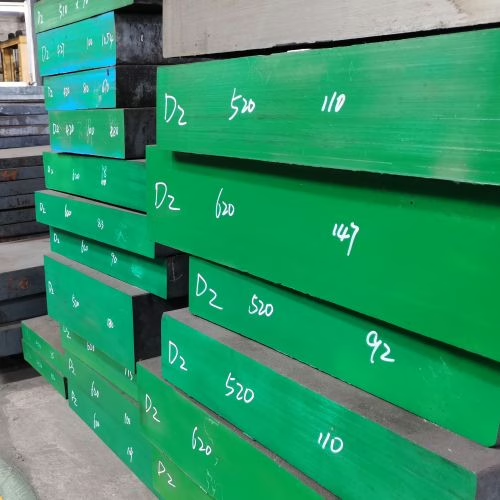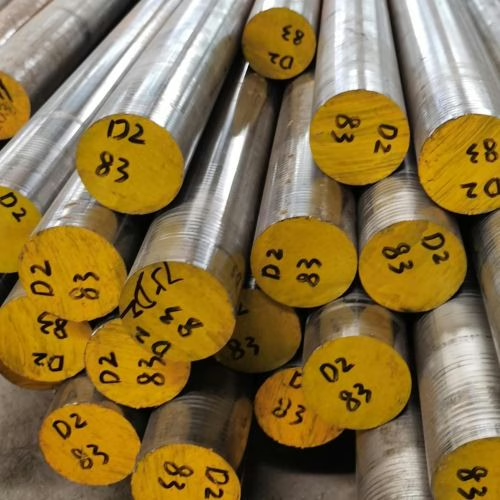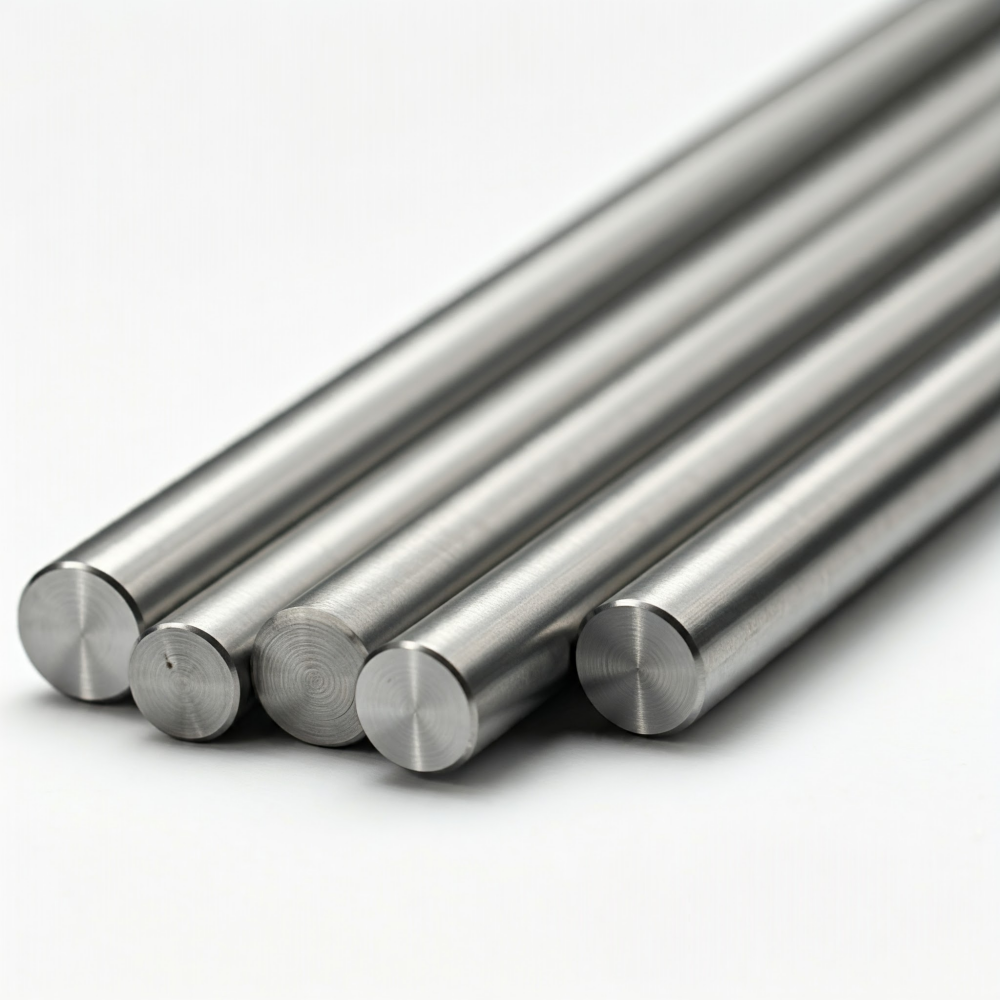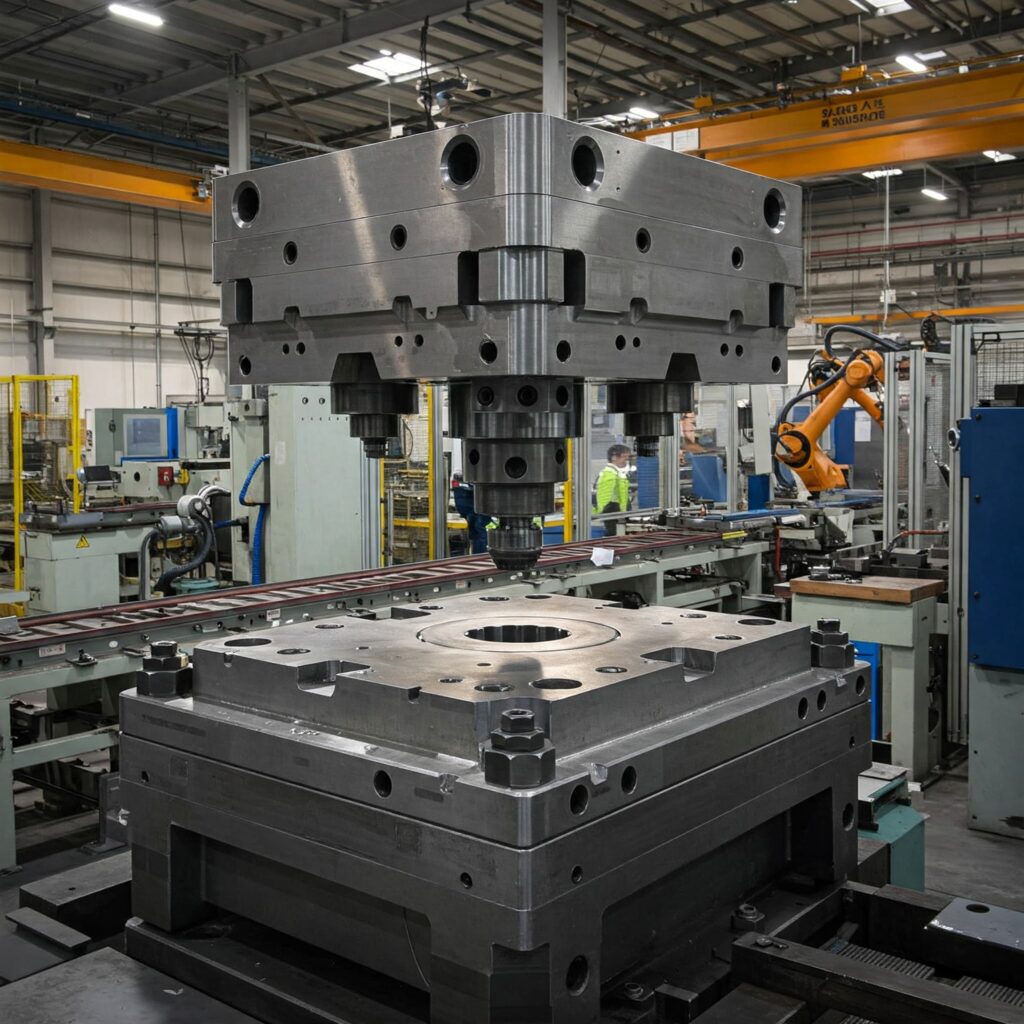D2 tool steel is classified under the “D” group, representing high-carbon, high-chromium cold-work tool steels. It is widely applied for long-run dies due to its superior wear resistance, good dimensional stability, and moderate toughness. D2 is considered a popular and often the most important reference for all cold-work tool steels. Common applications for D2 tool steel include blanking dies, cold-forming dies, drawing dies, gauges, knurls, lamination dies, punches, rolls, shear knives, slitter knives, and thread rolling dies.
For D2 tool steel, hardness is paramount because of its direct influence on wear resistance and the ability to maintain a sharp edge. Hardness is the resistance of a material to penetration, indentation, or abrasion. It is the most commonly stipulated requirement for tool steels and serves as a vital acceptance check for heat-treated tools.
The Foundation of Hardness: D2 Steel’s Chemical Composition
The D2 steel composition:
| Carbon (C) | Chromium (Cr) | Molybdenum (Mo) | Vanadium (V) | Manganese (Mn) | Silicon (Si) | Phosphorus (P) | Sulfur (S) |
| 1.40 – 1.60 | 11.00 – 13.00 | 0.70 – 1.20 | 0.50 – 1.10 | 0.10 – 0.60 | 0.10 – 0.60 | ≤ 0.030 | ≤ 0.030 |
The effect of composition on the hardness of D2 steel:
- Carbon: Enables high hardness and good wear resistance.
- Chromium: Forms chromium-rich alloy carbides, enhancing wear and abrasion resistance, and provides mild corrosion resistance.
- Molybdenum and Vanadium: Contribute to secondary hardening precipitates and enhance edge retention. Carbon and Vanadium are critical for microstructure and hardness.
Microstructural components contributing to D2 hardness:
- High-Carbon Martensitic Matrix. D2 steel achieves high hardness primarily through its martensitic matrix, formed by rapid quenching from the austenitizing temperature. The carbon atoms trapped in the interstitial sites of the martensitic crystal structure, along with a high density of dislocations, significantly increase its strength and hardness.
- Hard Alloy Carbides (Undissolved/Primary). D2 steel contains a large amount of undissolved hard alloy carbides, which are significantly harder than the martensitic matrix itself. The main types include: Chromium-rich M7C3, with hardness values ranging from 1500 to 1800 HV. And Vanadium-rich MC, with hardness ranging from 2000 to 2800 HV. The quantity, size, and distribution of these carbides are critical to the overall hardness and wear resistance. This process involves the precipitation of very fine alloy carbides (such as M2C or MC) from the tempered martensitic matrix, leading to an increase in hardness and improved tempering resistance
- Secondary Hardening Carbides. D2’s molybdenum and vanadium content enable secondary hardening during tempering. This process involves the precipitation of very fine alloy carbides (such as M2C or MC) from the tempered martensitic matrix, leading to an increase in hardness and improved tempering resistance
- Grain Refinement. The microstructure of D2 steel has a fine grain size, which helps to increase hardness. The presence of coarse primary carbides helps to pin austenite grain boundaries, maintaining a fine and relatively uniform grain size during austenitizing, thereby enhancing hardenability and overall hardness.


The effect of heat treatment on the hardness of D2 steel
Heat treatment significantly influences the hardness of D2 steel, primarily by transforming its microstructure and introducing various hardened phases.
- Austenitizing. Austenitizing D2 tool steel around 1010 °C (1850 °F) can achieve full hardness of 62-64 HRC upon air cooling. Higher austenitizing temperatures lead to more carbon and alloying elements dissolving into the austenite, which generally increases as-quenched hardness and hardenability. However, excessively high temperatures can also increase the amount of retained austenite, which is softer than martensite, potentially lowering the as-quenched hardness.
- Quenching. Quenching enables D2 steel to achieve high hardness; it is the process of converting austenite into martensite. D2 steel is an air-hardening steel, and compared to faster coolants such as oil quenching or water quenching, it minimizes deformation and internal stress.
- Tempering. D2 steel can achieve a hardness of 62 HRC with a single tempering at 400°F (205°C). With double tempering, the first tempering temperature is 960°F (515°C) and the second tempering temperature is 900°F (480°C), which can achieve a hardness of 58 HRC, and significantly improves wear resistance (often by 25-30%) due to refinement of the grain structure.
If you are looking for more information about this topic, please refer to How to Properly Heat Treat D2 Steel.
The Benefits of D2 Steel’s Hardness
- Excellent Wear Resistance. D2 often serves as a standard against which other tool steels are measured for abrasion resistance. Its wear resistance is improved by 30 to 40% over A2 steel. It is particularly effective in metal-forming operations where adhesive wear is a main mechanism, offering important improvements in die life.
- High Strength. D2 steel has a yield strength of 411 MPa and ultimate tensile strength (UTS) of 758 MPa. Its high carbon content, combined with the hardening process, is highly effective in achieving high strength, leading to hardness increases typically beyond 60 HRC.
- Suitability for Long Production Runs. The high hardness of D2 steel directly gives it high wear resistance, making it very advantageous in long-cycle manufacturing processes.
Challenges and Considerations Related to D2 Hardness
a. Difficult Machinability and Grindability
The combination of high chromium content and higher carbon content in D2 tool steel results in the formation of a large amount of M7C3 hard chromium-enriched carbides. These carbides exhibit excellent wear resistance at room temperature, making the steel difficult to machine and grind. These carbides act as hard obstacles to chip removal, causing wear on the machining tools. When properly annealed, D2 has a machinability rating of 45 compared to a 1% carbon steel rated at 100. Higher heat-treated hardness and the presence of larger carbides inversely relate to grindability.
b. Moderate Toughness
Toughness typically decreases with increasing wear resistance and hardness. D2 steel has excellent wear resistance, but its toughness is lower than that of steels with lower carbon or alloy content. The presence of hard particles, specifically the large volume fractions of alloy carbides (M7C3 type), in D2 steel contributes to its low toughness because they act as crack initiation sites.
Suppose significant increases in toughness are needed for D2. In that case, it is often better to select a different steel grade inherently designed for better toughness, rather than attempting to force D2 into an unsuitable “property envelope”.
c. Retained Austenite
Retained austenite is a common characteristic in D2 tool steel and needs careful management due to its impact on mechanical properties and dimensional stability. For D2 tool steel, an increase in retained austenite can lead to a decrease in overall hardness. Retained austenite is softer than martensite (face-centered cubic lattice).
Typical Applications Where D2 Hardness Shines
Dies and Punches
- Blanking
- Cold-forming
- Drawing
- Lamination
- Thread-rolling
- Piercing
- Coining
- Trimming (hot and cold)
- Extrusion (for aluminum and zinc)
Cutting Tools
- Shear blades
- Slitter blades
Other Applications
- Forming rolls
- Precision gauges
- Plastic molds (especially for abrasive materials)
- General tooling for stainless steel fabrication
D2 Hardness Compared to Other Tool Steels
- D2 vs. A2: D2 has higher wear resistance due to more chromium and carbon, while A2 offers better machinability and moderate toughness.
- D2 vs. O1: D2 offers 15% better abrasion resistance than O1.
- D2 vs. S7: S7 is significantly tougher but softer (48-58 HRC) and less wear-resistant than D2 (54-61 HRC).
- D2 vs. M2: M2 (63-65 HRC) is generally harder and has superior shock resistance, while D2 (60-62 HRC) offers better durability for cold work applications where wear resistance is paramount.
- D2 vs. Stainless Steel: D2 has superior hardness due to carbide formation and higher compressive strength, but moderate corrosion resistance compared to true stainless steels.
FAQ
Working Hardness: 56-62 HRC, depending on the specific application and tempering process.
As-Quenched Hardness: Can be higher, around 61-63 HRC, before tempering.
Required/Targeted Hardness: Often specified at 60-62 HRC for optimal performance in many tooling applications.
Overall Hardened Range: Hardened D2 can range from 54 to 65 HRC.
Yes, D2 tool steel is generally considered difficult to machine and grind.
D2 tool steel is considered difficult to weld.


